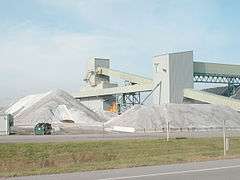Salt mining
A salt mine is a mine from which salt is extracted. The mined salt is usually in the form of halite (commonly known as rock salt), and extracted from evaporite formations.[1]

History

Before the advent of the modern internal combustion engine and earth-moving equipment, mining salt was one of the most expensive and dangerous of operations because of rapid dehydration caused by constant contact with the salt (both in the mine passages and scattered in the air as salt dust) and of other problems caused by accidental excessive sodium intake. Salt is now plentiful, but until the Industrial Revolution, it was difficult to come by, and salt was often mined by slaves or prisoners. Life expectancy for the miners was low.
In ancient Rome, salt on the table was a mark of wealth; those who sat nearer the host were "above the salt", and those less favored were "below the salt".
Ancient China was among the earliest civilizations in the world with cultivation and trade in mined salt.[2] They first discovered natural gas when they excavated rock salt. The Chinese writer, poet, and politician Zhang Hua of the Jin dynasty wrote in his book Bowuzhi how people in Zigong, Sichuan, excavated natural gas and used it to boil a rock salt solution.[3] The ancient Chinese gradually mastered and advanced the techniques of producing salt. Salt mining was an arduous task for them, as they faced geographical and technological constraints. Salt was extracted mainly from the sea, and salt works in the coastal areas in late imperial China equated to more than 80 percent of national production.[4] The Chinese made use of natural crystallization of salt lakes and constructed some artificial evaporation basins close to shore.[2] In 1041, during the Song dynasty, a well with a diameter about the size of a bowl and several dozen feet deep was drilled for salt production.[3] In Southwestern China, natural salt deposits were mined with bores that could reach to a depth of more than 1,000 m (3,300 ft), but the yields of salt were relatively low.[4] As salt is a necessity of life, salt mining played a pivotal role as one of the most important sources of Imperial Chinese government revenue and state development.[4]
Most modern salt mines are privately operated or operated by large multinational companies such as K+S, AkzoNobel, Cargill, and Compass Minerals.
Mining regions around the world
Some notable salt mines include:
| Country | Site(s) |
|---|---|
| Austria | Hallstatt and Salzkammergut. |
| Bosnia and Herzegovina | Tuzla |
| Bulgaria | Provadiya; and Solnitsata, an ancient town which Bulgarian archaeologists regard as the oldest in Europe and the site of a salt-production facility approximately six millennia ago.[5] |
| Canada | Sifto Salt Mine[6] in Goderich, Ontario, which, at 1.5 miles (2.4 km) wide and 2 miles (3.2 km) long, is one of the largest salt mines in the world extending 7 km2 (2.7 sq mi).[7] |
| Colombia | Zipaquirá |
| England | The "-wich towns" of Cheshire and Worcestershire. |
| Ethiopia, Eritrea, Djibouti | Danakil Desert, where manual labor is used.[8] |
| Germany | Rheinberg, Berchtesgaden, Heilbronn |
| Republic of Ireland | Mountcharles |
| Italy | Racalmuto, Realmonte and Petralia Soprana[9] within the production sites managed by Italkali. |
| Morocco | JMS salt mine in Khemisset. |
| Northern Ireland | Kilroot, near Carrickfergus, more than a century old and containing passages whose combined length exceeds 25 km. |
| Pakistan | Khewra Salt Mines, the world's second largest salt-mining operation, spanning over 300 km. |
| Poland | Wieliczka and Bochnia, both established in the mid-13th century and still operating, mostly as museums. Kłodawa Salt Mine. |
| Romania | Slănic (with Salina Veche, Europe's largest salt mine), Cacica, Ocnele Mari, Salina Turda, Târgu Ocna, Ocna Sibiului, Praid and Salina Ocna Dej. |
| Russia |
|
| United States |
|
Idiomatic use
In slang, the term salt mines, and especially the phrase back to the salt mines, refers ironically to one's workplace, or a dull or tedious task. This phrase originates from c. 1800 in reference to the Russian practice of sending prisoners to forced labor in Siberian salt mines.[13][14]
See also
- Salt mines
- General
References
- "Oilfield Glossary: Term 'evaporite'". Glossary.oilfield.slb.com. Retrieved 2012-02-13.
- Harris, Peter (2017). Studies in the History of Tax Law. 8. Hart Publications (published August 10, 2017). p. 518. ISBN 978-1509908370.
- Deng, Yinke (2011). Ancient Chinese Inventions. p. 41. ISBN 978-0521186926.
- Höllmann, Thomas O. (2013). The Land of the Five Flavors: A Cultural History of Chinese Cuisine. Columbia University Press (published November 26, 2013). p. 33. ISBN 978-0231161862.
- Maugh II, Thomas H. (1 November 2012). "Bulgarians find oldest European town, a salt production center". The Los Angeles Times. Retrieved 5 December 2012.
- "Industries in Goderich". Archived from the original on December 26, 2007. Retrieved 2008-02-08.
Sifto Canada Inc. [...] (Goderich Mine)
- "CBC-TV - Geologic Journey - Goderich, Ontario and Detroit Michigan". CBC 2012. Retrieved 3 August 2012.
- "Salt mine in the Danakil Depression in Ethiopia, 2015". Independent Travellers. independent-travellers.com. Retrieved July 14, 2017.
- "Italkali Spa - Production Sites". Archived from the original (online) on 2012-03-31. Retrieved 2011-05-09.
- "The Detroit Salt Company -- Explore the City under the City". Archived from the original (online) on 2009-04-12. Retrieved 2008-02-08.
- Spector, Joseph (13 Jan 2015). "American Rock Salt to expand in LIvingston". Democrat and Chronicle. Retrieved 20 July 2015.
- "All 17 Cargill Salt Miners Trapped on Underground Elevator Freed". NBC News. January 7, 2016. Retrieved January 7, 2016.
- "Definition of back to the salt mines | Dictionary.com". www.dictionary.com. Retrieved 2020-01-12.
- Houston, Natalie (2010-01-25). "The Salt Mines. Really??". The Chronicle of Higher Education Blogs: ProfHacker. Retrieved 2020-01-12.